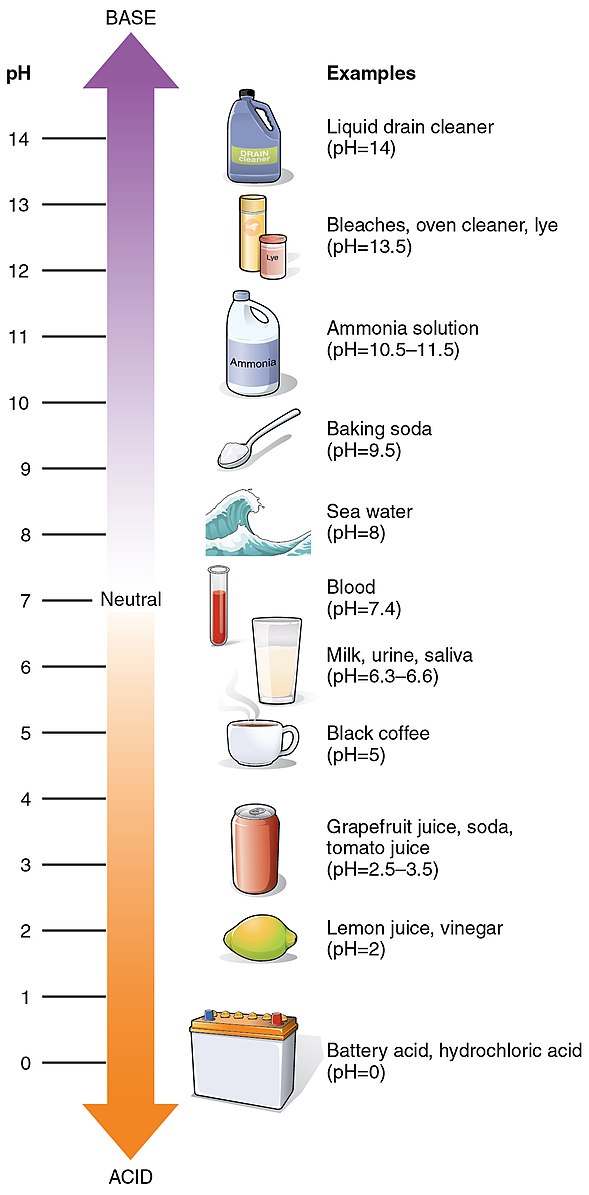The pH value of motor oil and water is a crucial factor in maintaining the health and performance of engines and equipment. New motor oil typically has a pH value between 7 and 8, indicating a neutral or slightly alkaline state. However, over time, the pH value can decrease due to the formation of acids, leading to potential issues such as corrosion. Similarly, the pH value of water can also change due to contamination, affecting its suitability for industrial applications.
Understanding the pH Scale
The pH scale ranges from 0 to 14, with 7 being the neutral point. Values below 7 are considered acidic, while values above 7 are alkaline or basic. The pH value of a substance is a measure of its hydrogen ion concentration, which determines its acidity or alkalinity.
Measuring the pH of Motor Oil and Water
 Image source: OpenStax College
Image source: OpenStax College
To measure the pH value of motor oil or water, specialized equipment such as pH meters or test strips are used. These tools provide accurate and reproducible results, allowing for the monitoring of pH levels over time and the detection of any changes that may indicate contamination or degradation.
Measuring the pH of Motor Oil
Measuring the pH of motor oil is important to ensure the oil’s performance and longevity. New motor oil typically has a pH value between 7 and 8, which indicates a neutral or slightly alkaline state. Over time, the pH value of motor oil decreases due to the formation of acids from oxidation and contamination.
Measuring the pH of Water
The pH value of water is also crucial, particularly in industrial applications where water is used as a coolant or lubricant. Fresh water typically has a pH value of 7, which is neutral. However, the pH value of water can change due to contamination from acids or alkalis, which can lead to corrosion or scaling in pipes and equipment.
Factors Affecting the pH of Motor Oil and Water
There are several factors that can affect the pH value of motor oil and water, including:
Contaminants and Chemicals
Acids formed from oxidation or contamination can lower the pH value of motor oil, while alkalis from cooling water or other sources can raise the pH value of water. Microorganisms such as bacteria and fungi can also affect the pH value of water, leading to the production of acids or alkalis that can cause corrosion or other issues.
Oxidation
Over time, the pH value of motor oil decreases due to the formation of acids from oxidation. This can lead to corrosion and other issues in the engine.
Cooling Water Contamination
In industrial applications, the pH value of water used as a coolant or lubricant can be affected by contamination from various sources, such as chemicals or microorganisms. This can lead to corrosion or scaling in pipes and equipment.
Adjusting the pH of Motor Oil and Water
In some cases, it may be necessary to adjust the pH value of motor oil or water to maintain optimal performance and prevent issues.
Adjusting the pH of Motor Oil
Adding a base such as baking soda can raise the pH value of an acidic motor oil, while adding an acid can lower the pH value of an alkaline oil. However, these remedies should only be used as a last resort, as they may not provide a permanent solution and could potentially cause further damage to the engine.
Adjusting the pH of Water
Similar to motor oil, adding a base can raise the pH value of an acidic water solution, while adding an acid can lower the pH value of an alkaline solution. Again, these remedies should be used with caution and only as a temporary solution.
Maintaining Optimal pH Levels
To maintain optimal pH levels in motor oil and water, it is important to regularly monitor the pH value and take appropriate action when necessary. This may include:
- Adding pH-adjusting additives to motor oil or water
- Replacing contaminated oil or water
- Implementing measures to prevent contamination, such as filtration or water treatment
By maintaining the proper pH levels, you can help ensure the longevity and performance of your engines and equipment, and prevent issues such as corrosion, scaling, and microbial growth.
Conclusion
The pH value of motor oil and water is a critical factor in maintaining the health and performance of engines and equipment. By understanding the importance of acidity and alkalinity, and taking the necessary steps to monitor and adjust pH levels, you can help ensure the optimal operation of your systems and prevent costly issues down the line.
References:
– What is pH?
– pH Test and TAN: Understanding the Importance of pH in Lubricants
– pH Data Book for Industrial Oil
